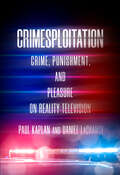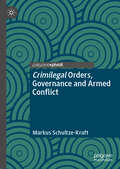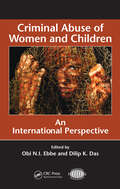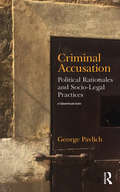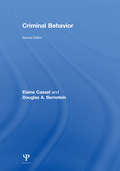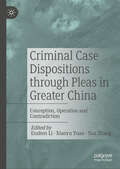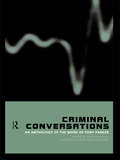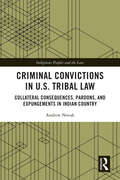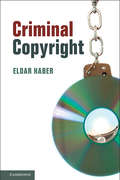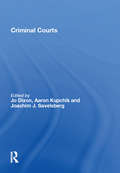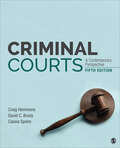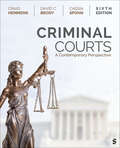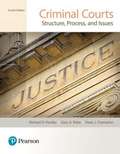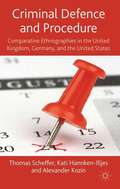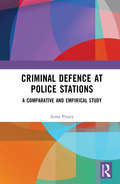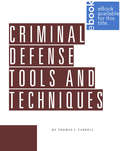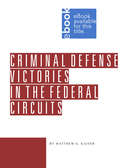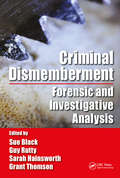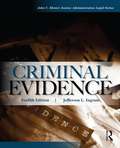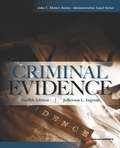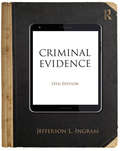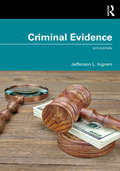- Table View
- List View
Crimesploitation: Crime, Punishment, and Pleasure on Reality Television (The Cultural Lives of Law)
by Daniel LaChance Paul Kaplan"Due to the graphic nature of this program, viewer discretion is advised." Most of us have encountered this warning while watching television at some point. It is typically attached to a brand of reality crime TV that Paul Kaplan and Daniel LaChance call "crimesploitation": spectacles designed to entertain mass audiences by exhibiting "real" criminal behavior and its consequences. This book examines their enduring popularity in American culture. Analyzing the structure and content of several popular crimesploitation shows, including Cops, Dog: The Bounty Hunter, and To Catch a Predator, as well as newer examples like Making a Murderer and Don't F**K with Cats, Kaplan and LaChance highlight the troubling nature of the genre: though it presents itself as ethical and righteous, its entertainment value hinges upon suffering. Viewers can imagine themselves as deviant and ungovernable like the criminals in the show, thereby escaping a law-abiding lifestyle. Alternatively, they can identify with law enforcement officials, exercising violence, control, and "justice" on criminal others. Crimesploitation offers a sobering look at the depictions of criminals, policing, and punishment in modern America.
Crimilegal Orders, Governance and Armed Conflict
by Markus Schultze-KraftComprehensively laying out the concept of crimilegality, this book presents a novel perspective on the relationship between what is conventionally termed organised crime and political order in the contemporary developing world. In hybrid crimilegal orders the moral, normative and social boundaries between legality and illegality-criminality are blurred, and through the violation of the official law, the illegal-criminal sphere of social life becomes legitimate and morally acceptable, while the legal turns illegitimate and immoral. Several examples of crimilegality and crimilegal governance in Colombia and Nigeria, including in relation to armed conflict termination, are used to illustrate these complex processes.
Criminal Abuse of Women and Children: An International Perspective (International Police Executive Symposium Co-Publications)
by Dilip K. Das Obi N.I. EbbeThe abuse of women and children transcends geographical boundaries as well as economic, cultural, religious, political, and social divisions. Comprised of the work of more than 20 academics and practitioners from around the world, Criminal Abuse of Women and Children documents the atrocities that have been committed against these victims from ancie
Criminal Accusation: Political Rationales and Socio-Legal Practices
by George PavlichAccusing someone of committing a crime arrests everyday social relations and unfurls processes that decide on who to admit to criminal justice networks. Accusation demarcates specific subjects as the criminally accused, who then face courtroom trials, and possible punishment. It inaugurates a crime’s historical journey into being with sanctioned accusers successfully making criminal allegations against accused persons in the presence of authorized juridical agents. Given this decisive role in the production of criminal identities, it is surprising that criminal accusation has received relatively short shrift in sociological, socio-legal and criminological discourses. In this book, George Pavlich redresses this oversight by framing a socio-legal field directed to political rationales and practices of criminal accusation. The focus of its interrogation is the truth-telling powers of an accusatory lore that creates subjects within the confines of socially authorized spaces. And, in this respect, the book has two overarching aims in mind. First, it names and analyses powers of criminal accusation – its history, rationales, rites and effects – as an enduring gateway to criminal justice. Second, the book evaluates the prospects for limiting and/or changing apparatuses of criminal accusation. By understanding their powers, might it be possible to decrease the number who enter criminal justice’s gates? This question opens debate on the subject of the book’s final section: the prospects for more inclusive accusative grammars that do not, as a reflex, turn to exclusionary visions of crime and vengeful, segregated, corrective or risk-orientated punishment. Highlighting how expansive criminal justice systems are populated by accusatorial powers, and how it might be possible to recalibrate the lore that feeds them, this ground-breaking analysis will be of considerable interest to scholars working in socio-legal research studies, critical criminology, social theory, postcolonial studies and critical legal theory.
Criminal Behavior
by Douglas A. Bernstein Elaine CasselCriminal Behavior explores crime as a developmental process from birth through early adulthood. It further examines the role that legal, political, and criminal justice systems play in the development of criminal behavior. Criminal Behavior:takes into account biological, genetic, developmental, familial, social, educational, cultural, political, an
Criminal Case Dispositions through Pleas in Greater China: Conception, Operation and Contradiction
by Yan Zhang Xiaoyu Yuan Enshen LiThis book investigates the policy implications, discursive ethos and practical realities of plea-based case dispositions in the criminal justice system of four Chinese-speaking jurisdictions, including Mainland China, Taiwan, Hong Kong and Macau. It aims to provide fresh and cutting-edge insights into important legal, social and cultural issues found throughout plea-based case dispositions in Greater China, but in a geographically specific manner – providing an in-depth view of issues that can help forge connections and inspire creative solutions for scholars gaining understanding of common problems across the societies in question. The book includes an introduction and conclusion with 9 chapters. Based on a diverse range of first-hand data and secondary sources of information, topics covered in the chapters represent multiangle perspectives and analysis that help to construct a sophisticated, intricate and evidence-based portrait of locally informed approaches to case disposition through pleas in Chinese-speaking societies.
Criminal Conversations: An Anthology of the Work of Tony Parker
by Keith SoothillThis anthology, selected by Tony Parker shortly before his death in 1996, provides the very essence of his quite distinctive contribution to criminology. In it he speaks intimately to all kinds of people including offenders, inadequates, professional criminals, sex offenders, frauds and false pretence merchants and prisoners on death row. Lyn Smith concludes with some reflections on his methodology. This collection celebrates an outstanding body of work and provides a fascinating insight into the criminal mind and experience. It will be compelling reading not only for those studying criminology, probation or prison studies, but also for the interested general reader.
Criminal Convictions in U.S. Tribal Law: Collateral Consequences, Pardons, and Expungements in Indian Country (ISSN)
by Andrew NovakThis book is the first comparative law study of collateral consequences of criminal conviction in all federally recognized Indian tribes in the lower 48 U.S. states, and the mechanisms for restoring civil rights in tribal law.Surveying the constitutions, codes, and ordinances of tribal jurisdictions reveals a broad range of consequences – the impact of which has not been comprehensively and critically examined. Like state and federal jurisdictions, tribal law attaches thousands of legal disabilities to tribal offices, business licenses and permits, social services, and civil rights for persons with criminal convictions. This is especially true in economically important industries such as gaming and resource extraction; additionally, rapidly changing areas such as marijuana regulation and sex offender registries expand the scope still further. This book catalogues restoration of rights procedures in tribal law, to include pardons, expungements, and record sealing. Collateral consequences have proliferated in tribal law because of the limitations of tribal criminal jurisdiction, including over non-tribal members. However, tribal collateral consequences risk contributing to overcriminalization and social exclusion for persons with previous criminal convictions, especially as Native Americans are already disproportionately impacted by the U.S. criminal justice system.This book will appeal to legal academics, scholars, and practitioners working in tribal criminal law, as well as to others with interests in Indigenous legal issues.
Criminal Copyright
by Eldar HaberSince the birth of criminal copyright in the nineteenth century, the copyright system has blurred the distinction between civil and criminal infringements. Today, in many jurisdictions, infringement of copyrighted materials can result in punitive fines and even incarceration. In this illuminating book, Eldar Haber analyzes the circumstances, justifications, and ramifications of the criminalization process and tells the story of how a legal right in the private enforcement realm has become over-criminalized. He traces the origins of criminal copyright legislation and follows the movement of copyright criminalization and enforcement on local and global scales. This important work should be read by anyone concerned with the future of copyright and intellectual property in the digital era.
Criminal Courts (International Library Of Criminology, Criminal Justice And Penology - Second Ser.)
by Aaron KupchikThe social organization of criminal courts is the theme of this collection of articles. The volume provides contributions to three levels of social organization in criminal courts: (1) the macro-level involving external economic, political and social forces (Joachim J. Savelsberg; Raymond Michalowski; Mary E. Vogel; John Hagan and Ron Levi); (2) the meso-level consisting of formal structures, informal cultural norms and supporting agencies in an interlocking organizational network (Malcolm M. Feeley; Lawrence Mohr; Jo Dixon; Jeffrey T. Ulmer and John H. Kramer), and (3) the micro-level consisting of interactional orders that emerge from the social discourses and categorizations in multiple layers of bargaining and negotiation processes (Lisa Frohmann; Aaron Kupchik; Michael McConville and Chester Mirsky; Bankole A. Cole). An editorial introduction ties these levels together, relating them to a Weberian sociology of law.
Criminal Courts: A Contemporary Perspective
by Cassia Spohn Craig T. Hemmens David C. BrodyComprehensive and engaging, Criminal Courts: A Contemporary Perspective explores all aspects of courts and related areas which are crucial to the criminal justice system. Written by three nationally recognized experts in the field, this text examines court structure, courtroom actors, trial and appeal process, and in addition, judicial decision making, specialized courts, and comparative court systems. By presenting up-to-date key cases, data, and current controversial discussions such as the death penalty or legalization of cannabis, this fifth edition provides students with opportunities to view topics from the perspectives of the participants involved in the process and take a position on the issue that is raised.
Criminal Courts: A Contemporary Perspective
by Cassia Spohn Craig T. Hemmens David C. BrodyComprehensive and engaging, Criminal Courts: A Contemporary Perspective explores all aspects of courts and related areas which are crucial to the criminal justice system. Written by three nationally recognized experts in the field, this text examines court structure, courtroom actors, trial and appeal process, and in addition, judicial decision making, specialized courts, and comparative court systems. By presenting up-to-date key cases, data, and current controversial discussions such as the death penalty or legalization of cannabis, this fifth edition provides students with opportunities to view topics from the perspectives of the participants involved in the process and take a position on the issue that is raised.
Criminal Courts: A Contemporary Perspective
by Cassia Spohn Craig T. Hemmens David C. BrodyComprehensive and engaging, Criminal Courts: A Contemporary Perspective deepens your students′ understanding by thoroughly examining the courts and their vital role in the criminal justice system. The Sixth Edition introduces updated content, including discussions on evolving marijuana laws, the balance between victims′ and defendants′ rights, court-administered bail, and domestic violence courts.
Criminal Courts: A Contemporary Perspective
by Cassia Spohn Craig T. Hemmens David C. BrodyComprehensive and engaging, Criminal Courts: A Contemporary Perspective deepens your students′ understanding by thoroughly examining the courts and their vital role in the criminal justice system. The Sixth Edition introduces updated content, including discussions on evolving marijuana laws, the balance between victims′ and defendants′ rights, court-administered bail, and domestic violence courts.
Criminal Courts: Structure, Process, And Issues
by Richard Hartley Gary Rabe Dean ChampionFrom the actors in the system, including judges, prosecutors, and defense attorneys, through the sentencing and appeals process, Criminal Courts provides comprehensive coverage of the United States Criminal Court systems in a succinct, readable approach. It examines issues confronting the system from historical, philosophical, sociological, and psychological perspectives, and throughout there are comparisons of court ideals with what actually happens in the courts. Comprehensive coverage of the processing of offenders from when they are arrested and charged with crimes, to when they are convicted and sentenced is presented, and throughout the text, practical, real-life applications of the topics and issues give the material meaning. Included to enhance learning are: evidence-based chapter openings that provide context to the chapter's material, boxes that discuss relevant case law, chapter summaries to reiterate the chapter learning objectives, and policy-oriented critical thinking exercises based on current issues facing the system.
Criminal Defence and Procedure
by Thomas Scheffer Kati Hannken-Illjes Alexander KozinProcedure is not just a programme or a nexus of formalities. It is something done by legal experts and lay participants in a highly concerted ensemble. Procedure frames and advances all law-relevant activities. This book, written by three authors from different disciplinary backgrounds, provides an in-depth comparison of criminal defence work in different legal cultures. Via an ethnographic comparison, this book also shows how defence work responds to the challenges of different procedural regimes and how it contributes to their individual outcomes. Criminal Defence and Procedure opens up new horizons for legal comparison, inviting novel understandings of procedural law as well as possibilities of legal reform.
Criminal Defence at Police Stations: A Comparative and Empirical Study
by Anna PivatyCriminal defence at the investigative stage has attracted growing attention due to the shifting focus of the criminal process onto pre-trial stages, and the recent European regulations adopted in this area. Increasingly, justice practitioners and legislators across the EU have begun to realise that ‘the trial takes place at the police station’. This book provides a comprehensive legal, empirical and contextual analysis of criminal defence at the investigative stage from a comparative perspective. It is a socio-legal study of criminal defence practice, which draws upon original empirical material from England and Wales and the Netherlands. Based on extensive interviews with lawyers, and extended periods of observation, the book contrasts the encountered reality of criminal defence with the model role of a lawyer at the investigative stage derived from European norms. It places the practice of criminal defence within the broader context of procedural traditions, contemporary criminal justice policies and lawyers’ occupational cultures. Criminal Defence at Police Stations questions the determinative role of procedural traditions in shaping criminal defence practice at the investigative stage. The book will be of interest for criminal law and justice practitioners, as well as for academics focusing on criminal justice, criminology, socio-legal studies, legal psychology and human rights.
Criminal Defense Tools and Techniques
by Thomas J. FarrellImprove your advocacy, speed trial preparation, avoid pitfalls, and be ready for surprises with Thomas J. Farrell's Criminal Defense Tools and Techniques. This book is loaded with proven angles of attack that will improve your effectiveness in all stages of your representation ... from initial interview through sentencing. Mr. Farrell supports his strategies with pattern argument language, model questions, 130 forms, real-life examples, checklists, and 1,400 case citations. Here is a small slice of what he covers: * identifying weaknesses in the prosecution's case * extracting concessions in pretrial motions and hearings * cross-examining government experts * defending specific crimes * mitigating the offense at sentencing * and much more For proven arguments, hundreds of forms, and effective tactics for criminal cases, purchase the latest edition of Criminal Defense Tools and Techniques by Thomas J. Farrell.
Criminal Defense Victories in the Federal Circuits
by Matthew G. KaiserCriminal Defense Victories in the Federal Circuits is not your average, run-of-the-mill case digest. This collection of almost 200 case summaries, culled from all 11 Circuits and the D.C. Circuit, is as entertaining as it is informative. Author Matthew G. Kaiser explains the law and the rationale underlying the courts' decisions in a narrative style that is smart, thoughtful, witty, and highly readable. Criminal Defense Victories in the Federal Circuits: * Covers a broad range of topics, from Evidence & Trials to Federal Sentencing to Searches & Seizures and Tax Offenses. * Demonstrates the many ways a federal criminal defendant can win: The indictment may be dismissed; the case may be remanded for a new trial or resentencing; a conviction may be reversed. A victory may be based on substantive or procedural grounds; judicial error; juror misconduct; or prosecutorial overreaching. * Gives detailed attention to the facts of each case, as well as the court's legal analysis, so that you can apply the same winning strategy to your own cases with similar facts. * Includes dozens of short summaries - victories "in brief" - in addition to the nearly 200 detailed summaries, to jumpstart your research. * Celebrates the beauty of a well-written opinion (and the sweet sorrow of a well-reasoned dissent). * Highlights resourceful and zealous defense lawyering, with examples of techniques you can apply in your practice.
Criminal Dismemberment: Forensic and Investigative Analysis
by Sue Black Guy Rutty Sarah V. Hainsworth Grant ThomsonCriminal Dismemberment is the first book to examine dismemberment as a phenomenon in the context of criminal acts. While the number of such dismemberment cases in any given country is often small, the notion of dismemberment captures the imagination, often leading many to question the motivations as to why anyone would perpetrate such an unnatural act. The act of dismemberment, in its original form, referred to cutting, tearing, pulling, wrenching or otherwise separating the limbs from a living being as a form a capital punishment. In today’s society, it has become associated most frequently with the criminal act of sectioning the remains of the dead in an attempt to conceal the death and dispose of the remains or make the process of identification of the deceased more difficult to achieve. Drawing on expertise from leading forensic anthropologists, pathologists, and forensic materials engineers, the book brings together much of the literature on criminal dismemberment—viewing it from the investigative, forensic, and social science perspectives. Key features include: Psychological analysis of the perpetrator Detailed examination of case studies, anonymized from recent investigations Difficulties encountered in a dismemberment investigation Tool mark analysis, including knives and saws, accompanied by over 120 detailed, full-color illustrations and photographs Serves as a unique and useful resource in the investigation of dismembered human remains The diverse backgrounds of the contributors offers a thorough account of such topics as the history of dismemberment, the forensic pathology in such cases, the importance of developing a common vocabulary in terminology used, the legal admissibility in dismemberment cases. As such, Criminal Dismemberment will serve as a comprehensive reference for students and practitioners alike.
Criminal Dissent: Prosecutions under the Alien and Sedition Acts of 1798
by Wendell BirdThe prosecution of dissent under the Alien and Sedition Acts affected far more people than previously realized. It also provoked the first battle over the Bill of Rights. Wendell Bird provides the definitive account of a dark moment in U.S. history, reminding us that expressive freedom and opposition politics are essential to a stable democracy.
Criminal Evidence
by Jefferson L. IngramIn addition to covering the basics of collecting, preserving and presenting evidence, Criminal Evidence, 12th edition, presents the latest developments in the law of evidence that are of interest to criminal justice personnel. Highlights include: chapter outlines, lists of key terms and concepts for each chapter, a glossary, and new, up-to-date cases in Part II. Thoroughly revised, updated, and streamlined to include recent case law on evidence Each chapter includes outlines, key terms and concepts, and review questions to aid understanding Appendices include a helpful glossary; Federal Rules of Evidence as amended and effective through December 1, 2013; Table of Jurisdictions That Have Adopted Some System of Uniform Rules for Regulating the Admission and Exclusion of Evidence through 2014; and Table of Contents of the Uniform Rules of Evidence with 2005 Amendments
Criminal Evidence
by Jefferson L. IngramIn addition to covering the basics of collecting, preserving and presenting evidence, Criminal Evidence, 12th edition, presents the latest developments in the law of evidence that are of interest to criminal justice personnel. Highlights include: chapter outlines, lists of key terms and concepts for each chapter, a glossary, and new, up-to-date cases in Part II. Thoroughly revised, updated, and streamlined to include recent case law on evidence Each chapter includes outlines, key terms and concepts, and review questions to aid understanding Appendices include a helpful glossary; Federal Rules of Evidence as amended and effective through December 1, 2013; Table of Jurisdictions That Have Adopted Some System of Uniform Rules for Regulating the Admission and Exclusion of Evidence through 2014; and Table of Contents of the Uniform Rules of Evidence with 2005 Amendments
Criminal Evidence
by Jefferson L. IngramCriminal Evidence is a respected and trusted introduction to the rules of criminal evidence for criminal justice students and professionals. The first half of this book follows the Federal Rules of Evidence in its explanation of how evidence is collected, preserved, and presented in criminal court. The second half provides a selection of relevant criminal court cases that reinforce these basics and contextualize how these rules are currently practiced. This text offers readers a practical understanding of how concepts of evidence operate to convict the guilty and acquit the innocent. Part of the John C. Klotter Justice Administration Legal Series, this thirteenth edition provides many updates, including new references to recent Supreme Court cases, such as the decision on same-sex marriage, and a current version of the Federal Rules of Evidence. Student aids include chapter outlines, key terms and concepts lists, a table of cases cited, and online case study questions and glossary. Teacher resources include an instructor’s guide, test bank, and PowerPoint slides.
Criminal Evidence
by Jefferson L. IngramCriminal Evidence is a well-respected and trusted introduction to the rules of criminal evidence for criminal justice students and professionals. Part I of this book generally follows the order and logic of the Federal Rules of Evidence in its explanation of how evidence is collected, preserved, and presented in a criminal court proceeding. Part II provides a selection of edited, relevant criminal court cases that reinforce these basics and provide the context of how these rules are currently practiced. Readers gain an understanding of how concepts of evidence operate to convict the guilty and acquit the innocent. This 14th Edition provides many updates, new references to recent Supreme Court cases, and a current version of the Federal Rules of Evidence. Student aids include chapter outlines, key terms, concepts lists, a glossary, a table of cases cited, and online case study questions. Teacher resources include an Instructor’s Guide, test bank, and PowerPoint slides. Updated with all the newest relevant law, this book is appropriate for undergraduate students in criminal evidence and related courses.
